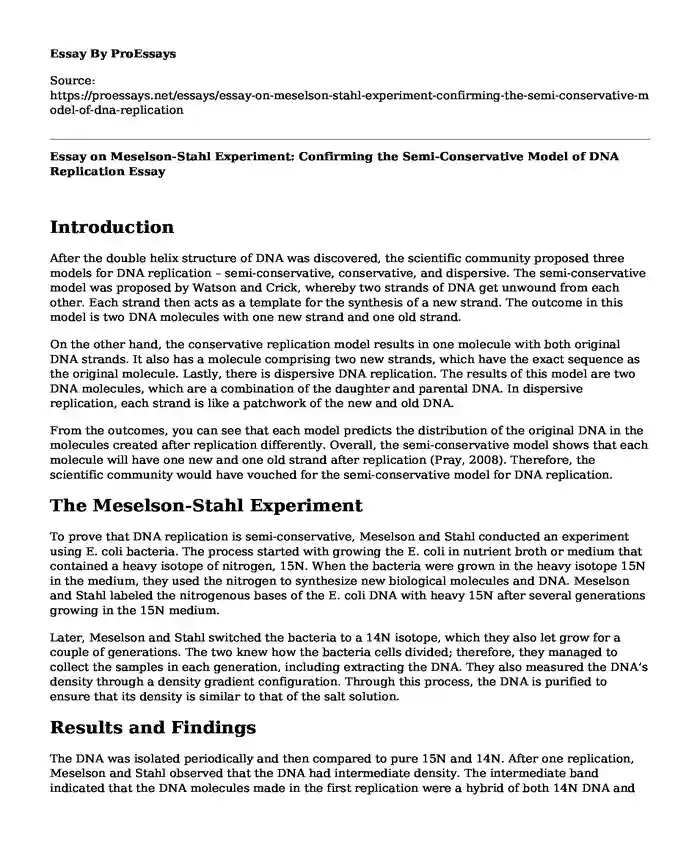Introduction
After the double helix structure of DNA was discovered, the scientific community proposed three models for DNA replication – semi-conservative, conservative, and dispersive. The semi-conservative model was proposed by Watson and Crick, whereby two strands of DNA get unwound from each other. Each strand then acts as a template for the synthesis of a new strand. The outcome in this model is two DNA molecules with one new strand and one old strand.
On the other hand, the conservative replication model results in one molecule with both original DNA strands. It also has a molecule comprising two new strands, which have the exact sequence as the original molecule. Lastly, there is dispersive DNA replication. The results of this model are two DNA molecules, which are a combination of the daughter and parental DNA. In dispersive replication, each strand is like a patchwork of the new and old DNA.
From the outcomes, you can see that each model predicts the distribution of the original DNA in the molecules created after replication differently. Overall, the semi-conservative model shows that each molecule will have one new and one old strand after replication (Pray, 2008). Therefore, the scientific community would have vouched for the semi-conservative model for DNA replication.
The Meselson-Stahl Experiment
To prove that DNA replication is semi-conservative, Meselson and Stahl conducted an experiment using E. coli bacteria. The process started with growing the E. coli in nutrient broth or medium that contained a heavy isotope of nitrogen, 15N. When the bacteria were grown in the heavy isotope 15N in the medium, they used the nitrogen to synthesize new biological molecules and DNA. Meselson and Stahl labeled the nitrogenous bases of the E. coli DNA with heavy 15N after several generations growing in the 15N medium.
Later, Meselson and Stahl switched the bacteria to a 14N isotope, which they also let grow for a couple of generations. The two knew how the bacteria cells divided; therefore, they managed to collect the samples in each generation, including extracting the DNA. They also measured the DNA’s density through a density gradient configuration. Through this process, the DNA is purified to ensure that its density is similar to that of the salt solution.
Results and Findings
The DNA was isolated periodically and then compared to pure 15N and 14N. After one replication, Meselson and Stahl observed that the DNA had intermediate density. The intermediate band indicated that the DNA molecules made in the first replication were a hybrid of both 14N DNA and 15N DNA (Szeberényi, 2012). The results suited two models – semi-conservative replication and dispersive replication, but not conservative replication.
Meselson and Stahl did a second replication to establish which model was accurate between the two. The second DNA centrifugation produced two bands. One maintained a similar position to the intermediate density obtained in the first replication, while the second appeared higher. It was labeled with 14N. An indication that the DNA was replicated semi-conservatively.
In the third and fourth replications, the hybrid band became increasingly fainter, while the lower-density band became more pronounced. These results indicated that DNA replication is semi-conservative (Szeberényi, 2012). They show that each strand in a DNA molecule acts as a template for the synthesis of a new strand. Although Meselson and Stahl used E. coli in the experiment to prove this hypothesis, the semi-conservative DNA replication model is a universal mechanism.
References
Pray, L. A. (2008). Semi-conservative DNA replication: Meselson and Stahl. Nature Education, 1(1), 98.
Szeberényi, J. (2012). The MeselsonStahl experiment. Biochemistry and Molecular Biology Education, 40(3), 209-211.
Cite this page
Essay on Meselson-Stahl Experiment: Confirming the Semi-Conservative Model of DNA Replication. (2024, Jan 29). Retrieved from https://proessays.net/essays/essay-on-meselson-stahl-experiment-confirming-the-semi-conservative-model-of-dna-replication
If you are the original author of this essay and no longer wish to have it published on the ProEssays website, please click below to request its removal:
- Culture Clash
- Essay Sample in Ethics and Cultural Considerations in Technical Communication
- Modern Examples of Durkheim's Image of Mechanical Societies Essay Example
- Mexican Fire Opals - Essay Sample
- Essay Example on State Tested Nursing Assistant: Caring for the Community
- Paper Example on Doctors & Patients: Meeting Challenges in Treatment through Technology
- Free Essay Example on Glacier Bivachny: A Flowing Glacier in Central Pamir







